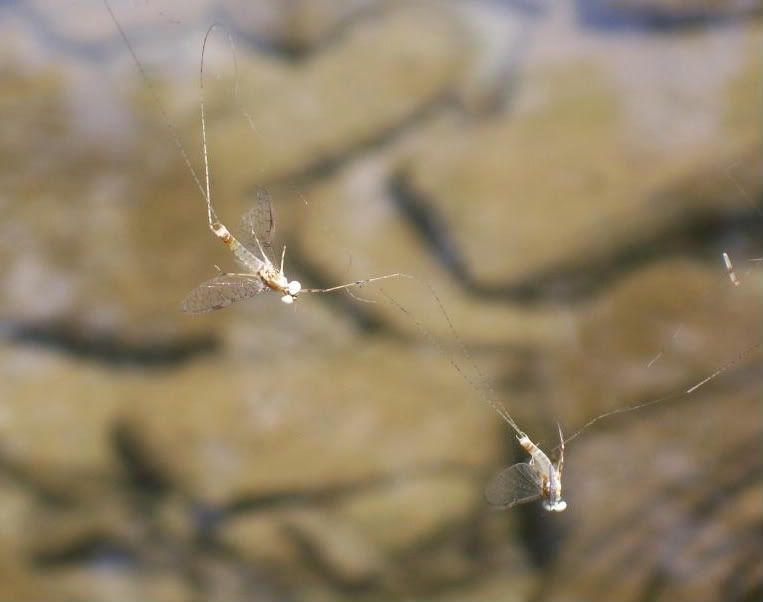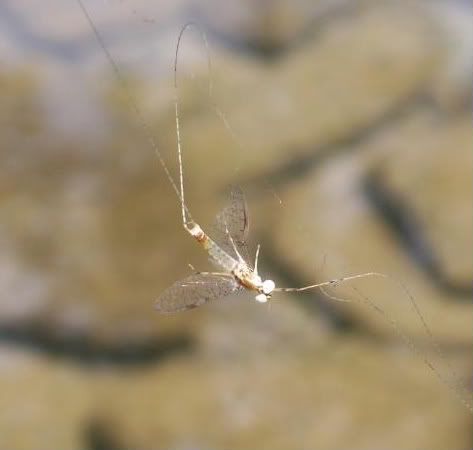
Blue-winged Olives
Baetis
Tiny Baetis mayflies are perhaps the most commonly encountered and imitated by anglers on all American trout streams due to their great abundance, widespread distribution, and trout-friendly emergence habits.
Featured on the forum

Troutnut is a project started in 2003 by salmonid ecologist Jason "Troutnut" Neuswanger to help anglers and
fly tyers unabashedly embrace the entomological side of the sport. Learn more about Troutnut or
support the project for an enhanced experience here.
Grannom on Jul 22, 2008July 22nd, 2008, 7:42 am EDT
Any ideas on this one? From NW PA. About a size 18, found around noon today in a spider web on a stream not known for either trout or bugs. I have never seen a substantial hatch of anything on this stream, but today I say these little guys along with some tricos. The stream gets pretty warm and I was fishing for smallies and chubs...yes the little bottom-feeders that everyone hates... Anyway, let me know if you have any ideas.

Mike

Mike
"Be calm - you're there..." "...Tell yourself there's no rush, even if there is."
-John Gierach
-John Gierach
GONZO on Jul 22, 2008July 22nd, 2008, 10:11 am EDT
Hard to say for sure without a closer shot, Mike, but they look like little Leucrocuta spinners (male). Leucrocuta is a very underrated hatch at this time of year, even on legitimate trout streams.
Wbranch on Jul 22, 2008July 22nd, 2008, 10:50 am EDT
While no bug guy like many here I'd bet a dozen flies it is a Luekon shuck. (White fly spinner)
Catskill fly fisher for fifty-five years.
Taxon on Jul 22, 2008July 22nd, 2008, 11:11 am EDT
Mike-
I believe your mayfly photo to be of two Maccaffertium pulchellum male imagos.
I believe your mayfly photo to be of two Maccaffertium pulchellum male imagos.
Grannom on Jul 22, 2008July 22nd, 2008, 12:00 pm EDT
I appreciate everyone's input. I don't think that it is Ephoron leukon...these flies were slightly smaller, it's too early in the year and the veination on the wings is different. Also, leukon has 3 tails to my knowledge and both of these flies have only 2. Here is a closer picture of the same fly. Maybe this will help.

Mike

Mike
"Be calm - you're there..." "...Tell yourself there's no rush, even if there is."
-John Gierach
-John Gierach
GONZO on Jul 22, 2008July 22nd, 2008, 12:42 pm EDT
Wbranch,
E. leukon would be larger, the wings (even of the male spinners) retain a milky appearance and are unmarked except for a dark leading edge (no very dark cross-veins), the legs (except for the forelegs of male spinners) are atrophied and small, and the eyes are smaller and dark. (The eyes of heptageniids fluoresce in bright light.) Compare to John's photos:
http://www.wiflyfisher.com/ephoron-leukon-mayfly-hatch.asp
Roger,
It does appear to be a heptageniid, and I considered Maccaffertium and Stenacron, but they are all larger than a standard #18 (which I take to be about 6-7mm). Leucrocuta and a few Nixe or Heptagenia are in that size range. Also it seems that the darkened cluster of cross-veins are in the first space behind the costa, whereas Maccaffertium, Stenonema, and Stenacron tend to have clustered cross-veins or dark marks in the third space. I don't have examples of the other Leucrocuta (I believe that aphrodite and juno are lighter in color), but you can see the translucent abdomen on the darker hebe in Don Chandler's photo:
http://bugguide.net/node/view/203347/bgimage
E. leukon would be larger, the wings (even of the male spinners) retain a milky appearance and are unmarked except for a dark leading edge (no very dark cross-veins), the legs (except for the forelegs of male spinners) are atrophied and small, and the eyes are smaller and dark. (The eyes of heptageniids fluoresce in bright light.) Compare to John's photos:
http://www.wiflyfisher.com/ephoron-leukon-mayfly-hatch.asp
Roger,
It does appear to be a heptageniid, and I considered Maccaffertium and Stenacron, but they are all larger than a standard #18 (which I take to be about 6-7mm). Leucrocuta and a few Nixe or Heptagenia are in that size range. Also it seems that the darkened cluster of cross-veins are in the first space behind the costa, whereas Maccaffertium, Stenonema, and Stenacron tend to have clustered cross-veins or dark marks in the third space. I don't have examples of the other Leucrocuta (I believe that aphrodite and juno are lighter in color), but you can see the translucent abdomen on the darker hebe in Don Chandler's photo:
http://bugguide.net/node/view/203347/bgimage
Taxon on Jul 22, 2008July 22nd, 2008, 1:00 pm EDT
Lloyd-
Oops. Didn't notice that Mike mentioned a size. Guess I need to read better and analyze less.
Oops. Didn't notice that Mike mentioned a size. Guess I need to read better and analyze less.
Grannom on Jul 22, 2008July 22nd, 2008, 1:02 pm EDT
Lets leave it at Leucrocuta for now. The stream is right down the street and I'll be fishing it all summer. I will take more and hopefully better pictures in the future and we'll see if we can't narrow it down.
Gonzo- I was not able to find photos of L. juno or L. aphrodite. Please do let me know if anything else comes up. Thanks
Mike
Gonzo- I was not able to find photos of L. juno or L. aphrodite. Please do let me know if anything else comes up. Thanks
Mike
"Be calm - you're there..." "...Tell yourself there's no rush, even if there is."
-John Gierach
-John Gierach
GONZO on Jul 22, 2008July 22nd, 2008, 1:04 pm EDT
Quite alright, Roger, since a heptageniid ID is about all that's fairly certain, I'll split the dozen flies with you. ;)
Grannom on Jul 22, 2008July 22nd, 2008, 1:07 pm EDT
NOTICE- I have made a huge mistake. This fly is NOT a size 18. It is clearly 16, if not slightly larger. I just guessed earlier, but now looking at some hooks, I would put it at a size 16. I am sorry guys. Well let me know what we may be looking at now.
"Be calm - you're there..." "...Tell yourself there's no rush, even if there is."
-John Gierach
-John Gierach
GONZO on Jul 22, 2008July 22nd, 2008, 1:10 pm EDT
Well, that puts it nearer the borderline. If you can get a close-up of the wing, it should help to resolve any question about the genus in Heptageniidae.
Grannom on Jul 22, 2008July 22nd, 2008, 1:14 pm EDT
"Be calm - you're there..." "...Tell yourself there's no rush, even if there is."
-John Gierach
-John Gierach
GONZO on Jul 22, 2008July 22nd, 2008, 1:52 pm EDT
I think it will take a clear shot of the wing (and maybe of the markings on the back) to really be able to pin it down. If it was a large #16 (say, 8-9mm), it would start to be in range for some smaller Maccaffertium or Stenacron males. If that dark blob near the leading edge of the forewing resolves into a hashmark in the third space, it would be a Stenacron something like this one:
http://bugguide.net/node/view/203191/bgimage
If it resolves into dark cross-veins in the first space, it's still probably Leucrocuta. If the cross-veins are clustered more in the second and third space, it could be Maccaffertium.
By the way, Mark, you are quite right about the three tails on Ephoron females--they never molt into spinners and mate as duns. However, the Ephoron males (the ones with the long forelegs in John's photo) do molt and have two tails.
http://bugguide.net/node/view/203191/bgimage
If it resolves into dark cross-veins in the first space, it's still probably Leucrocuta. If the cross-veins are clustered more in the second and third space, it could be Maccaffertium.
By the way, Mark, you are quite right about the three tails on Ephoron females--they never molt into spinners and mate as duns. However, the Ephoron males (the ones with the long forelegs in John's photo) do molt and have two tails.
Wbranch on Jul 22, 2008July 22nd, 2008, 9:56 pm EDT
I too didn't pay attention to the size mentioned in the initial post.
Catskill fly fisher for fifty-five years.
GONZO on Jul 26, 2008July 26th, 2008, 10:18 am EDT
Since the size range has been revised upwards, I'm now leaning more toward a Maccaffertium ID on this one. I don't think it is pulchellum, though. Descriptions of that species mention that the mesoscutellum is entirely white. It could be modestum, mediopunctatum, or terminatum. These "cream cahills" are very difficult to separate. A clear photo and millimeter measurement might help, but given the variability (especially of modestum) it would still be difficult to be sure.
Taxon on Jul 26, 2008July 26th, 2008, 12:16 pm EDT
Lloyd-
Hmmm. Be cautious with such a posture. Leaning just a bit too far risks tipping over.
Since the size range has been revised upwards, I'm now leaning more toward a Maccaffertium ID on this one. I don't think it is pulchellum, though.
Hmmm. Be cautious with such a posture. Leaning just a bit too far risks tipping over.
GONZO on Jul 26, 2008July 26th, 2008, 12:29 pm EDT
You're probably right about the precarious posture, Roger, but teetering on the brink is a habit of mine. :)
Quick Reply
Related Discussions
Topic
Replies
Last Reply
0
Oct 19, 2006
by GONZO
by GONZO
8
Jun 5, 2007
by Dinerobyn
by Dinerobyn
9
Jun 17, 2015
by Oldredbarn
by Oldredbarn



















